Culture & Philosophy
Dr. Warthan’s Steampunk Culture & Philosophy
We are going to explore the greater meanings and underlying qualities that make up the modern Steampunk culture. The superficial clinical definitions are insufficient to describe what Steampunk really is, and what it means to be part of that community. The premise of “what would happen if…” is at the very heart of Steampunk.
Technical Definition: For the purely uninitiated, here is what any good Doctor will tell you about Steampunk:
Steampunk is a sub-genre of science fiction and speculative fiction, that came into prominence during the 1980s and early 1990s. The term denotes fictional works set in an era or world where steam power is still widely used — usually the 19th century, and often Victorian-era Britain — but with prominent elements of either science fiction or fantasy, often featuring futuristic technology as the people of this historical period would have envisioned it to look like, i.e. based on a Victorian perspective on fashion, culture, architectural style, art, etc. This technology may include fictional machines like those found in the works of H. G. Wells and Jules Verne, or real technological developments like the computer, but occurring at an earlier date.
Other examples of steampunk contain alternate history-style presentations of “the path not taken” for such technology as dirigibles, analog computers, or digital mechanical computers (such as Charles Babbage’s Analytical engine).
Steampunk is often associated with cyberpunk and shares a similar fan base, but developed as a separate movement (though both have considerable influence on each other). Apart from time period and level of technological development, the main difference between them is that steampunk settings usually tend to be less dystopian than cyberpunk.
Various modern utilitarian objects have been modded by individual artisans into a pseudo-Victorian mechanical “steampunk” style, and a number of visual and musical artists have been described as steampunk.
Steampunk. (2010, August 4). In Wikipedia, The Free Encyclopedia. Retrieved 18:15, August 5, 2010, from http://en.wikipedia.org/w/index.php?title=Steampunk&oldid=377196673
There’s a lot of good information in the Wikipedia article, and it’s an excellent starting point.

History: Since Steampunk is mostly based on the styles of the Victorian and Edwardian eras, it’s important to understand that period of history. The Victorian era was the time period between 1837 and 1901 in which Her Majesty Queen Victoria reigned in England. The Victorian era was succeeded by the Edwardian era. That era was the time period between 1901 and 1910, and England was shortly ruled by Queen Victoria’s son Edward.
Steampunk borrows from the styles of both periods which include Gothic, Classical, Neo-classical, Art Nouveau, Baroque, Georgian, and Medieval. Mostly we see influences from Gothic, Classical, and some Medieval. In Steampunk, these are typically referred to as Neo-Victorian (pre-1900’s) and Neo-Edwardian (post-1900’s).
Starting with the Victorian era, great advancements were made in science which changed 19th-century society in profound ways. Trains and ships (both steam-driven) were the primary methods of moving goods and materials as well as people. Also, gas lamps had entered the scene. While Steampunk bases its technology on this time period, it is amusing to note that the leaps in sewage technology are ignored.
Components: Now that the basic definition is out of the way, we can discuss the common elements of the Steampunk culture. Like any culture, there are elements of art, literature, music, fashion, technology, movies/TV, games, language, mythology, religion, and politics. At first glance, a hardened Steampunk enthusiast may raise an eyebrow at some items, like politics; but they do exist and we will discuss those.
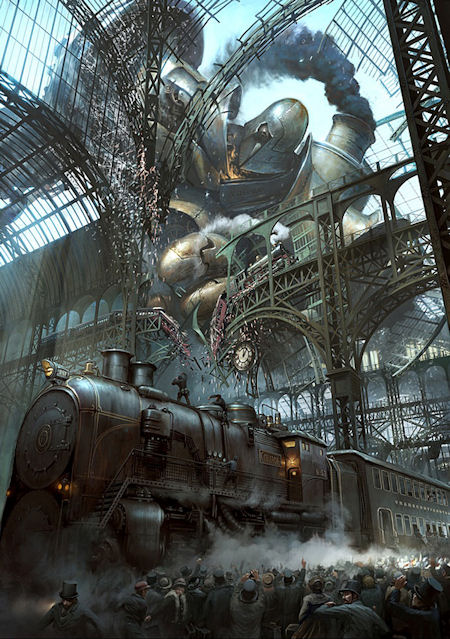
Art: The artistic expressions are what Steampunk is probably most noted for. Searching the Internet one can easily find a vast array of paintings, drawings, models, metal-works, contraptions, and scenes. They commonly have the trademark goggles, Victorian-styled clothing, steam-powered vacuum-tube technology, and are all modeled after the cultured style of the late 19th century.
The better works explore the “what if” ideas in a very apparent manner. What if dirigibles were used as farm equipment? What if there were giant steam-driven war machines used to terrorize the populace? What if guns didn’t use gunpowder? What if mechanical men came from mechanical wombs? What if Aether held up giant sky ships? Art can often give us the best realistic possibilities, and the best cautionary tales. Building a giant robot may sound like fun, but in practical application, I think we all know that it would be used for world domination.
Check out what I’ve posted in Omega7Red’s art collection.

Literature: Steampunk probably has most of its roots in literature, though one would find it difficult to find Steampunk-specific books. All the Punk variations originate from Cyberpunk. Cyberpunk is essentially a “What if computers took over the world?” e.g., the Matrix and Terminator movies are Cyberpunk. Cyberpunk stories usually pit man against artificial intelligence. Dieselpunk is another variation where the aesthetics are based on the interbellum period of World War II, typically between 1920 and 1945. Nazipunk is based on the idea of an alternate history where Nazi Germany was victorious during World War II (The Man in the High Castle), and usually explores the dystopia that would have resulted from our modern age. Atomicpunk assumes an early Cold War state between the USA and the USSR, and usually includes another alternate history where the Soviet Union did not collapse. And then there’s Clockpunk where instead of steam we find gears and springs; otherwise, Clockpunk is a close cousin of Steampunk.
Steampunk-themed books are sometimes called Gaslight Fantasy but are essentially the same thing. Like any science fiction or fantasy novel, anything can happen within the rules of the sub-genre. Consider the typical Dungeons & Dragons-themed fantasy books. There are always wizards, swords, magic, and dragons. They are usually set in a medieval setting with pre-industrial age technology. Beyond that, anything goes. Look at the Lord of the Rings books, or The Chronicles of Narnia. They all share the common elements of swords, magic, and medieval lands; however, the two series are incredibly different.
In our Steampunk counterparts, we have rules based on Neo-Victorian assumptions and technological limits that are centered around the modern Steampunk culture. The rules are far more flexible, but most of the common elements remain intact. You may find 19th-century technology mixed with modern technology, which is the kind of mix that almost never happens in traditional fantasy. You could easily find spaceships in place of dirigibles, alternate histories, or super variations of Steampunk. For example, the movie Wild Wild West was clearly Steampunk, but the Victorian elements had been replaced with Old West elements (sometimes called Western Steampunk). And there are other super variations, like Carnival, Lovecraftian, and Medieval.
Check out these novels: Anubis Gates, Perdido Street Station, The Difference Engine, Whitechapel Gods, Steampunk, as well as a long list of Steampunk books.

Music: Originally, brass bands were popular during the Victorian era, and it was common to hear the music in various parks. The musical component of Steampunk is a topic of much debate. It’s not fair to say that any form of modern music is Steampunk. Personally, I would think that classical music reimagined for the modern age would fit well. There’s “Bond”, a group of girls playing electric string instruments. I’ve listened to them, and they are very talented, but I’m not sure that’s what we’re looking for.
Steampunk is more about character, theme, and attitude. We have “Abney Park” who market themselves explicitly as a Steampunk band, and I’m not sure how to judge them, but it doesn’t seem quite right. We also have Doctor Steel who clearly has the correct character and attitude; and while he’s not exactly Steampunk, I think I like him best. I’ll just pray Eminem doesn’t decide to do Steampunk rap (Dr. Dre would be a better choice).
Check out these musicians: Doctor Steel, Abney Park, Bond Girls, Voltaire (not to be confused with Cabaret Voltaire nor François-Marie Arouet), Vernian Process, and Rose Coven.

Fashion: Steampunk fashion is Cosplay. Whatever you see, there will always be goggles. The articles of clothing created by the community are usually works of art themselves. I commonly see a mix of Victorian, Edwardian, Western, and Goth styles to create stunning expressions of personal fashion. Dressing the part and emerging one’s self into the experience is where Steampunk really shines. There are millions of photos all over the Internet, and I encourage you to look.
Most of the fashion is period authentic; realistic and updated. Those creations look like something that could have actually evolved. But a lot of it is also printed cogs and gears on earrings, almost Hollywood meets Steampunk, for which I reserve judgment. Flickr would be a great place to start.
Check out Flickr’s collection of Steampunk fashion.
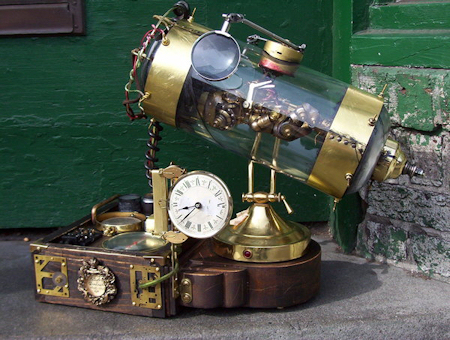
Technology: This is the counterpart to Steampunk fashion. Once the clothing is created, we simply must make a steam-powered Gatling-gun that fires Tesla-guided bullets filled with deadly Aether; or a watch with way too many gears. Some of the Steampunk technology can actually be practical. After all, there really was an age of Steam-powered devices. Those usually take the form of clocks, watches, lamps, terrariums, and unfortunately water pipes (bongs). Others are non-functional and promise super-human strength, the ability to fly, or any number of Sci-Fi ideas.
Usually, the technology is expressed as a form of art and re-imagines a current technology (e.g., the eye-Pod). I’m personally most fascinated by mechanical analog computers. These fantastic technologies are not limited to physical creations but are critical components in literature, drawings, paintings, and such. Again, there are millions of photos and drawings all over the Internet, and I encourage you to look.
Check out Steampunk technology images on Google Images.

Movies & TV: There are Steampunk influences throughout the entire movie and television industries. Some are obvious like Around the World in 80 Days, Steamboy, and The Secret Adventures of Jules Verne. Most are less obvious like Doctor Who, 9, and Firefly. Technically, none of these are pure Steampunk, but they all borrow from Steampunk to some varying degree. Obviously, the short-lived Secret Adventures of Jules Verne is almost entirely based on Steampunk, but it is still not 100% (in my opinion).
Unfortunately, mainstream media is dominated by rigged reality shows, dull comedies, predictable dramas, all against that which thought-provoking science fiction and fantasy have always struggled. It’s a good thing we all know how to read.
Check out: The Secret Adventures of Jules Verne, Doctor Who, Firefly, Steamboy, The Prestige, Wild Wild West, Golden Compass, Around the World in 80 Days, Stardust, and 9.

Games: Interactive fiction is one of the more satisfying elements of Steampunk. Games combine art, music, narrative, and other components to provide the user with an overall experience that is greater than the sum of its parts. Few games truly embrace Steampunk, but even some of the half-hearted low-budget attempts are still entertaining and worth considering.
My favorite Steampunk game is Syberia; it also happens to be my favorite adventure game of all time. Actually, to be honest, Syberia is a Clockpunk game. As I said earlier, Clockpunk and Steampunk are closely related. It’s close enough that I’ll call it Steampunk.
There is also a collection of Steampunk-themed games that include table-top RPG (maps and dice), Story Gaming (everyone’s telling part of the story), board games, card games, and Live Action Role Playing (LARP). Probably the best way to get exposed to non-video games is to attend a large function like SteamCon.
Check out: Syberia, Aqua, Castlevania, Bioshock, Final Fantasy, Arcanum: Of Steamworks and Magick Obscura, Iron Kingdoms, Castle Falkenstein, Deadlands, and Unhallowed Metropolis.
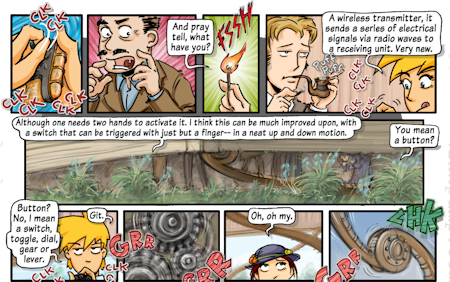
Language: While there is no linguistically independent language of Steampunk, there is a definite sub-dialect. One usually finds this as amusing titles or descriptions containing many scientific-sounding words using many syllables that nearly obfuscate what is being said. Examples include “The Beneficent and Magnanimous Doctor Warthan”, or “Supernatural and Troublesome Ectoplasmic Apparitional Management (S.T.E.A.M.)”.
Also, there are deliberate word and idiom substitutions. Examples include Datascobe (computer), Aerodrome (airport), Photonglobe (light bulb), Bioscope (cinema), and Aethergraph (e-mail).
I would like to meet someone who has mastered conversational steam-speak and have a lengthy conversation with them. What must be particularly difficult is writing a novel using such language. I write science fiction, and I can tell you from experience that the mere act of creative writing can be very challenging. Any author with the courage to write this dialect into their works has my respect and admiration.
Check out these Comics: Battle Chasers, League of Extraordinary Gentlemen, Steampunk, Girl Genius, StinkPump.
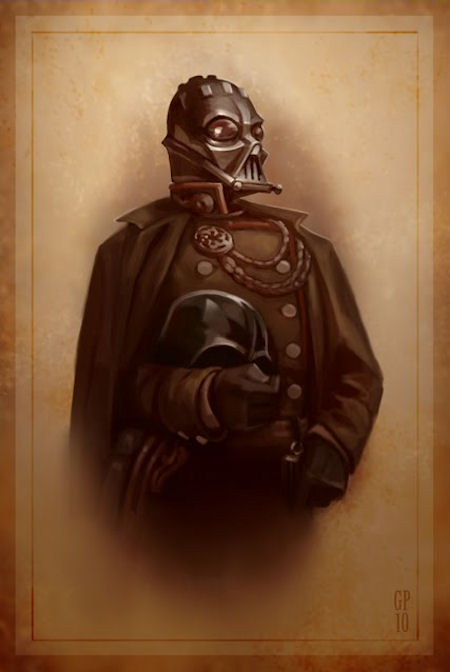
Mythology: Steampunk does not have its own unique mythology. Keep in mind that re-imagining other ideas are at the very heart of Steampunk. What we instead find are new ways of telling old stories. If you’ve ever seen the theatrical adaptation of Romeo + Juliet with Leonardo DiCaprio, you’ll see a classic Shakespeare tragedy played out in a modern setting with guns, gas stations, and helicopters. Steampunk re-imagines classic mythos in the same way. It takes the old tales and puts the Steampunk twist on them. The results are awesome, and we find new satisfaction in enjoying familiar myths.
However, some rare examples of existing stories have been directly adapted as Steampunk’s own mythos and are usually left as is, such as 20,000 Leagues Under the Sea, From the Earth to the Moon, and Frankenstein.
Check out the winning entries from Steampunk Myths and Legends.

Religion: Here’s where it gets ugly. Most Steampunk enthusiasts are undefinable in nature. They are artistically expressing themselves, and consequently liberal in their attitudes with little or no regard for traditional conservative values. Naturally, they don’t usually mesh well with the conservative Christian church. While I’m sure many of them are Christians or devout in other traditional faiths, I doubt I will ever see a Neo-Victorian Bible-Thumper on my porch asking me if I know Jesus.
That doesn’t mean Steampunkers don’t appreciate faith. Many of them do, and some of them re-imagine their faith and express it in other ways. A great example of Theological Fantasy is the Chronicles of Narnia. It is so well done, that most readers fail to realize that Jesus Christ and Christian values have been translated into Aslan the Lion and the adventures of the “Sons of Adam” and “Daughters of Eve.”
It is the same with Steampunk, though it is not always so cleverly done. Phillip Pullman’s trilogy “His Dark Materials” which became “The Golden Compass” movie violently attacked church dogma and drew harsh criticism from the Catholic Church. But we are talking about the same Christians who denounced Harry Potter books as a subversive effort to lure unsuspecting children into the occult; I’ve heard the same things said about Hannah Montanna and the Smurfs. While I do not condemn the church in a fashion similar to Pullman, I applaud his courage of conviction to print unpopular speech.
There have been some arguments that Steampunk is a religion. That’s stupid. Steampunk is no more a religion than the Marine Corps or Japan is. Japan has a very unique culture, so does the Marine Corps. Both have their own history, art, literature, music, dialect, mythos, and sense of identity. But that doesn’t stop people from calling the USMC a cult (which it is not), or the nation of Japan a bunch of Shintoist Devil-Worshippers (which they are not). Steampunk has no church, no dogma, no faith, no canon, and they have never burned people at the stake over a box of live cats for thinking the world was not flat.
The most Steampunk will ever involve itself with religion will be in the same fashion science fiction has always done. It will ask what if, provide hope or caution, and present ideas or criticisms of current dogma. My favorite sci-fi prediction of religion is from the late Arthur C. Clarke’s book The Hammer of God in which Christianity and Islam had merged into a new prominent religion called Chrislam.
In The Hammer of God, an asteroid was heading to Earth that would destroy all life. Governments were going to nuke the rock. The Chrislam church was trying to sabotage the mission so that everyone would transmit themselves to God (a process resulting in instant death).
Anyways, here’s the simplest analogy of Steampunk and religion: When asked “who was Judas Iscariot?” Most people would say “the person who betrayed Jesus.” A Steampunker might say “a much-loved disciple of Christ.” Both statements are absolutely true (from a Biblical point of view). However, the Steampunker has chosen to see things differently and expresses it thusly.

Politics: And you thought religion was ugly. The political scene is not what one would expect. Generally, Steampunkers are anarchist in nature but entertain the ideas of forming a sodality where traditional forms of government are excluded. Once again, Steampunk is re-inventing ideas. Some prefer total anarchy where piracy rules, which reminds me of Burning Man for some reason. Others envision world dominance by installing a benevolent totalitarian dictatorship. Others still re-invent historical feudal systems and communist ideas. What seems to be dominant in the absence of the concept of government. These ideas are usually expressed in their various works of art, literature, and film. Ultimately decentralized.
But what about real politics? Not likely. The Steampunk enthusiast is escaping reality, much in the same way one reads a book to imagine different possibilities. While some people enjoy reading books about how much real-life sucks, most escape into imagined worlds of fiction free from stupid American politics and foreign policy. I can see no reason why any Steampunker would want to ruin their fantasy by dragging political reality into it.
Oh sure, there are pro/anti-gay, pro/anti-abortion, pro/anti-illegal immigration, Democrat, Republican, far-right/left people who love Steampunk, and some may actually have the balls to express their political views within the Steampunk forum. But it would be rare, and as a rule, real politics has no place in the Steampunk culture.
Like religion, it is likely that Steampunk will continue to exist in ignorance of politics. It is infinitely more likely that Steampunk will only touch on politics in the historical sense. We’ve all seen Abe Lincoln with a Gatling gun attached to his arm. Yeah, Steampunk is like that.

Sexuality: Clearly there are strong sexual overtones in Steampunk that are seen in gaslamp erotica, art, and especially at events. Most of the people who are now Steampunk came from Goth, Punk, and other alternative scenes. Consequently, there is a large cross-section of LGBTQIA (but not “M,” not on my watch). The Steampunk culture is more welcoming than most groups and does not discriminate based on sexual orientation, color, creed, national origin, and such.
The Steampunkers themselves express a wide variety of views and practices. Some appreciate the positive values of treating others as Gentlemen and Ladies and try to adopt these customs and courtesies while abandoning the Victorian class system. Others express their sexuality in a very modern way, especially women who enjoy dressing provocatively (which I do sincerely appreciate). Also, there are feminists who are greatly concerned about promoting any Victorian standards which could further the exploitation of women as sexual objects.
There’s even a Steampunk-themed swingers club in Paris France called Le Nautilus (sacré bleu!). Though, unlike the SCA (Society for Creative Anachronism), Steampunk events are (allegedly) not orgy events. Being Steampunk will not get you laid (but it sure can’t hurt). It may only seem odd for the uninitiated.
It never hurts to expand one’s knowledge of sexuality in alternative cultures. For that, I would recommend reading what Violet Blue (NSFW) has to say. While she appears to not be a fan of Steampunk, she is called a “Sexual Futurist” and is highly known as a well-respected authority on Sexuality and Sex Education in America.
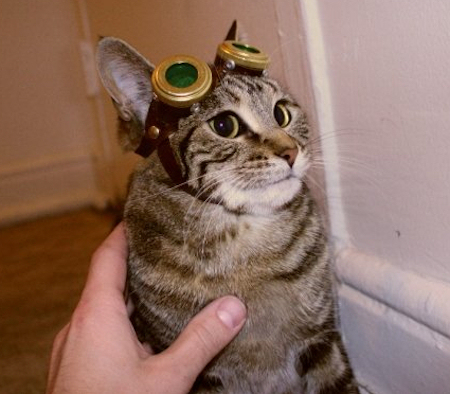
Philosophy: Now it’s time for me to whip out my Neo-Victorian Socrates and Clockwork Plato, and Philosophise you some. Philosophy in Steampunk examines the nature of Steampunk itself, and since Steampunk is continuously evolving, it is a topic of heated debate (as it should be). The world we live in exists as one kind of illusion. Perception is reality, and if you perceive something to be real, it becomes your truth.
The problem with reality is that we are not gods here, and have little control over this world. But with our imaginations, we can create illusions containing new worlds and new ideas in which we are free to be whatever we want. Some are so convincing, that we would trade our lives here to live there instead of here. We create our own illusions or borrow others and for a while allow ourselves to perceive those different illusions as reality.
In exploring other realities, we examine our own lives and other ideas. We then act to make the world a better place for ourselves and our community. And herein lies the danger of becoming a false prophet as we reach for enlightenment.
With Steampunk, like-minded people come together to share and express their ideas based on a common theme. My interpretations of Steampunk are meant to be middle-grade, but there are some who take the philosophical concepts very seriously. For example, Professor Calamity of Catastrophone Orchestra writes about Steampunk philosophy in this forum post. At first glance, it looked like the mad rumblings of a crazy person; the high-brow metaphysical fantasies of what Punk really is.
Authentic Steampunk is not an artistic movement but an aethestictechnological movement. The machine is freed from the chains of effeciency and to embrace desire and dreams. The sleekness of optimal engineering is replaced with the necessary ornamentation of true function. Imperfection, chaos, chance and obsolence are not to be seen as faults but as ways of allowing spontaneous liberation from predictable perfection. The factory of consciousness is overthrown by beautiful entropy. Steampunk creates a seamless paradox between the practical and the fanciful. It expands the horizons of both art and technology by being freed from the maniacal control of man’s puropses. Steampunk technology is neither slave nor master but partner in the exploration of unknowable territories of both art and science.
I actually had to read it twice to really get an understanding of what the Professor was trying to say. And now I think what he’s posted is worth reading; I may not agree with him 100%, but it’s a point of view that deserves attention. The good Professor is well-read and has put a lot of thought into his claims. After all, true philosophy is about examining the world around us and discussing how to make the world a better place.
A system of morality which is based on relative emotional values is a mere illusion, a thoroughly vulgar conception which has nothing sound in it and nothing true. – Socrates

Death: All good things end. It is often said that on the east coast Steampunk is already dead. Cultures change, skirts get shorter, and you end up missing the USSR (ah, simpler times). Then your kids start listening to your generation’s music and playing it on a video game.
It is our mortality that defines us. Steampunk like other alternative cultures will eventually die and fade into obscurity. Like bones in a grave, it’ll never be completely gone; well, maybe in a few hundred years. What’s important is what we take from this time and carry into the future. All cultures are progressive; they constantly examine their own values, grow a little, embrace some good ideas and discard a few bad ones. If they don’t, their entire civilization ends.
This is exactly the relationship between Steampunk and the Victorian/Edwardian eras. Those times are no more, and those cultures have ceased to exist. While modern Europe has continuously evolved since those times, the Steampunk culture has taken the positive things directly from that era so that we could enhance our modern culture in a unique way. While we do not ignore history, we can take the good things and move forward into the next era. In this way, we can preserve the good things instead of letting them end.
I created this page in 2010. Now in 2022, things have changed. Where is Steampunk now? For a brief period between 2007 and 2012, Steampunk was everywhere. As I predicted, it has faded away into the background noise of our lives. Or… has it? Look at a list of Steampunk Conventions and they seem to be going just as strong as ever. I think Steampunk has become more mainstream appearing at various Cons with Cosplay and what-not. Excellent…
Feedback: Do you think I’m wrong? Have I left something out? Is it misspelled? Is the link broken? Am I an Idiot? Please comment openly; I read all comments posted by the community, and I will use any feedback to enhance this page.
